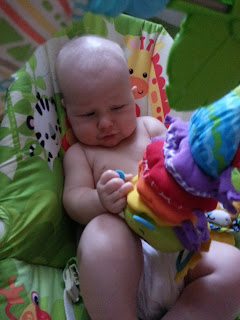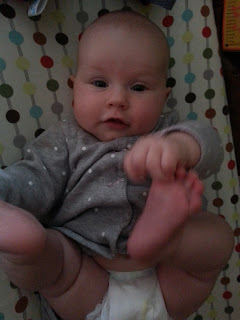I've spent a lot of time with her since she was born in January. As I went about my days on maternity leave, it occurred to me how many similarities she shares with the average event audience*.
Not that adults aren't in possession of more complex systems--they are--but there are some basic brain concepts that don't change as we age. We just tend to forget about them because we feel like adults should be able to willfully manage their states--while we forgive babies for getting fussy when they're overly tired or hungry or need to see something new.
However, the baby who wiggles in their chair when not entertained will become the adult who takes their brain out for a walk during an event or presentation. You can't see them disengage--but that doesn't mean it isn't happening.
Here are 5 things that Nadia has in common with an event audience:
1. Attention span
The attention span of a baby is fairly short. Guess what? So is an adult's attention span. Unless you change the way information is presented every 5-7 minutes--people tune out. Nadia may love-love-love her stuffed musical caterpillar (and your audience may love-love-love the new product roll out) but she doesn't want to play with it for minutes on end.Your audience can't sustain attention for 45 minutes...an hour...without additional stimulation.
2. Novelty rules
If there is something new in the room, the baby's attention snaps-to and holds. It's pretty amazing (and sometimes frustrating when trying to get her to focus on a necessary task). Adults are the same way. Something new, novel, interesting, different, etc. will captivate our attention.This is why adding a little WEIRDNESS into your presentation is really memorable. This is why disruptions that don't support your message can be REALLY distracting.
3. Change the pattern
Along the same lines--when Nadia is very upset about something she needs a pattern interrupt before she can be calmed down. Whistling while she's crying, for instance, will cause her to stop and re-focus. Your audience probably won't be crying (on the outside, anyway), but sometimes they can be righteously angry about something (layoffs, perceived ineffectiveness, a change in policy, etc.).They can carry that anger with them; totally ignoring the Very Important Message you're trying to get across. Interrupt the pattern before launching into the new plan. You need to stop the fussing before they can be effective listeners again.
4. Energy is continually exhausted without intervention
No matter how many hours of sleep she got the night before, by the end of the day Nadia is a ball of fuss. She just cannot process any more information. I've seen audiences like this too. The event planner jams the schedule so full that you get a tired, cranky audience.Naps can help a baby, but what does an audience need? Time to process information. To recharge. Maybe make that networking dinner end VERY early after a full day of general sessions and workshops. Give breaks in between presenters and let the audience write down their key takeaways.
5. Basic needs cannot be neglected
Maslow's hierarchy of needs is pretty straightforward with a baby. They first want food and sleep and shelter and safety. Your audience also wants these things. This seems like a really obvious point, but basic needs aren't always met at an event in favor of saving a few dollars (let's make this a stretch break and not a snack break) or even due to unforeseen circumstances. Feed your audience. Let them get full nights of sleep. Give them breaks. Make sure they can see the screens and stage. Make sure they're comfortable.Use of pacifiers is optional.
*Adorableness of your audience may vary.







No comments:
Post a Comment